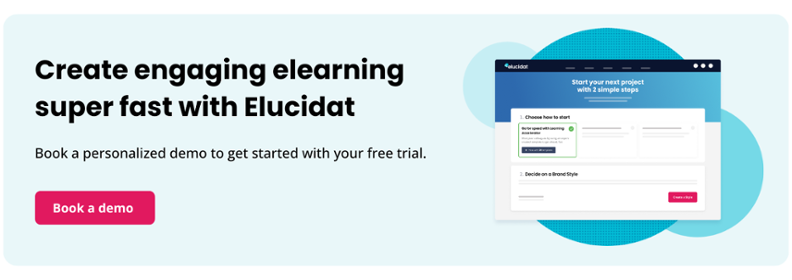Learning outcomes vs objectives: Driving results in corporate training
5 minute read
What’s the point of training without results? Learning should deliver real impact for your organization – and that starts with knowing your learning outcomes vs objectives. But what do these terms really mean? How are they different? And can they work together to drive training effectiveness? In this article, we break it all down.

Table of contents
What are learning outcomes and learning objectives?
Learning outcomes vs objectives: what’s the difference?
A learning objective is what a learner will be able to do by the end of training.
Example:
By the end of the training, learners will be able to describe the global warming process, list emissions sources, and explain how to stop global warming.
These actions can be achieved immediately after completing the course or program. Learning objectives describe the knowledge, skills, and competencies gained straight away.
A learning outcome, on the other hand, is the result of training in the real world. It’s about learners applying what they’ve learned in practice.
Example:
Learners will change their everyday behaviors to save energy, reducing the organization’s electricity use by 10%.
The best learning outcomes are measurable like this one, so you can see whether the training is having the desired impact.
When it comes to learning outcomes vs objectives, it’s not a case of choosing between them. Instead, they work best together. Learning outcomes define the desired results of the training, while learning objectives tell you what to include in the training to reach those results.
Learning outcomes vs objectives: Why the distinction matters
Learning outcomes and objectives may seem similar, but they’re not the same. And it’s crucial to keep them distinct. Here are three reasons why.
Clarity and focus
Learning outcomes focus on the long-term impact you want your training to achieve. Learning objectives clarify the specific content needed to reach those outcomes.
Measurement and evaluation
Learning outcomes evaluate the overall success of training, linking it to organizational goals through performance metrics or KPIs. In contrast, learning objectives let you track progress during the learning experience through tools like assessments.
Design and implementation
Learning outcomes bookend a project. They define the training you need at the start and measure its impact at the end. Learning objectives come in the middle, guiding content creation based on the desired outcomes.
Create your learning goals with the 5C Framework
Not sure where to start when it comes to learning outcomes vs objectives?
The 5C Framework is a simple process for creating successful learning. The first step, Capture, is all about making a plan. Here’s how it can help you create learning outcomes vs objectives.
What are you doing?
Start by identifying your training goal: what are you trying to achieve and why? What will your project do in the real world that you can measure? These answers will guide the creation of your learning outcomes.
Who is it for?
Next, define your target audience, what you need them to do differently, and any barriers that stand in the way. This helps you create the behavioral change part of your learning outcomes. Knowing learner gaps and challenges is the foundation for developing learning objectives too.
What will make it a success?
Success might go beyond learning something new. Perhaps you want to drive motivation, awareness, or engagement too. If so, include these goals in your learning outcomes and design your objectives to support them.
Follow this structured planning process to align your learning outcomes and objectives with your organization’s needs. The result? Maximum training effectiveness.
Find out more about using Capture and the 5Cs to plan your project.
How to write learning outcomes vs objectives in corporate training
What about writing learning outcomes vs objectives? Having a general idea is one thing, but putting it into clear, actionable words is another.
Don’t worry. These tips and examples can help.
Creating learning outcomes
Create your learning outcomes before your objectives. Think of it as starting with the big picture, and then drilling down into the steps needed to achieve it.
Good learning outcomes describe two things:
- The change you want to see in your learners
- The measurable impact this change will have on your organization
Example:
Learners will be able to identify workplace hazards and act appropriately, reducing on-site incidents by 20% over the next six months.
Always align your learning outcomes with organizational goals – such as improving workplace safety in this example.
Creating learning objectives
To help write learning objectives, a specific set of verbs – action words – is often used. These are based on Bloom’s Taxonomy, a model that categorizes learning into levels, from basic knowledge to advanced skills.
Corporate training typically targets the lowest two levels: remember and understand. That’s because learners often haven’t yet had the chance to reach the next highest level and apply what they’ve learned.
Here are the verbs for those levels:
Understand
Describe, explain, paraphrase, restate, give original examples of, summarize, contrast, interpret, discuss.
Remember
List, recite, outline, define, name, match, quote, recall, identify, label, recognize.
Using specific verbs helps you create clear, actionable, and easy to evaluate objectives. Let’s use them to write three learning objectives that align with the earlier learning outcome:
By the end of this training, learners will be able to list common on-site hazards, describe the correct process to address each hazard, and explain the potential consequences of failing to do so.
Notice how each objective directly supports the broader learning outcome. Together, they create a roadmap for learners to achieve meaningful, measurable change.
Conclusion
Learning outcomes vs objectives: they’re not the same. To create learning that delivers the right results for your organization, it’s essential to distinguish between them.
The good news? It doesn’t need to be complicated. Start defining your learning outcomes and objectives in simple steps using the Capture guide from the 5C Framework.
Ready to create training programs that deliver real results? Book a demo with Elucidat and see how our elearning authoring platform helps organizations, like yours, achieve measurable success.




